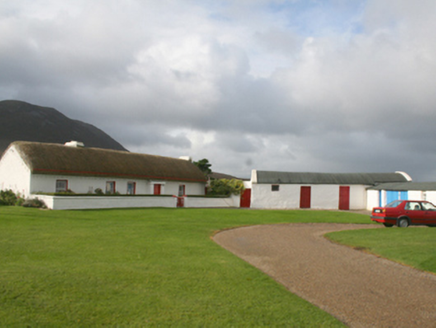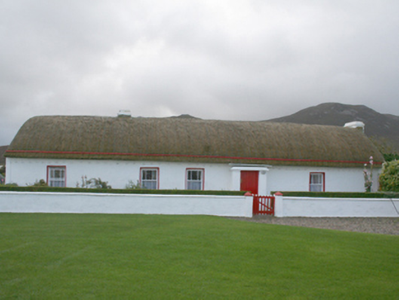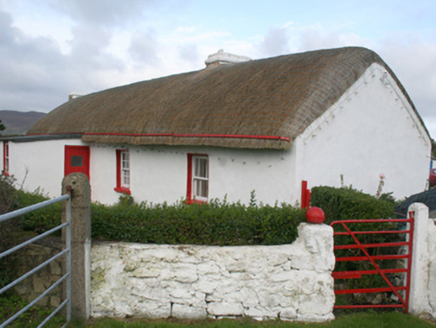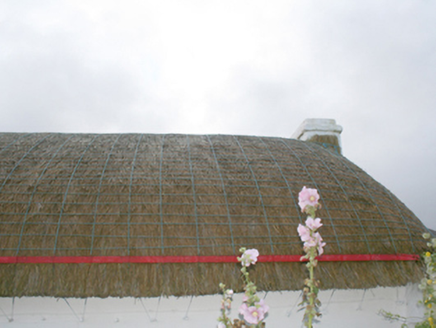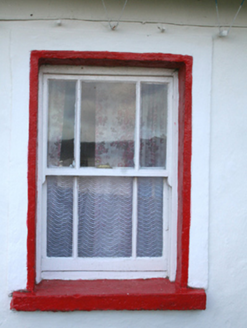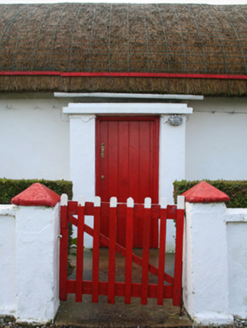Survey Data
Reg No
40900307
Rating
Regional
Categories of Special Interest
Architectural, Technical
Original Use
House
In Use As
House
Date
1840 - 1900
Coordinates
234842, 448336
Date Recorded
02/10/2008
Date Updated
--/--/--
Description
Detached five-bay single-storey vernacular house, built c. 1850 and extended c. 1900, having windbreak porch to front (south), adapted bed outshot to rear (north) with added door, and with single-storey addition to the rear (north). Round pitched thatch with rope lattice, stays and steel pegs, limewashed render to chimneystacks, monopitch tar roof to outshot. Limewashed rendered rubble stone walls. Square-headed window openings with painted sills, smooth rendered reveals, and with three-over-three pane horned timber sliding sash windows. Square-headed door opening to windbreak porch having battened timber door. Set in own grounds bound by hedge and limewashed rubble stone wall rendered to front with cast-iron gate and capped piers. Detached three and four-bay single-storey outbuildings having barrel-vaulted tar and felt roofs, limewashed rendered rubble stone walls, and square-headed openings. Located to the north-east of Clonmany.
Appraisal
This appealing and intact example of a vernacular house retains its early form and character, and is an appealing feature in the scenic rural landscape to the north-east of Clonmany, located close to the coast at Pollan Bay. Its integrity is enhanced by the retention of much of its salient fabric including timber sliding sash windows and battened timber door. Of particular interest in the survival of the thatch roof, although recently renewed, which is now sadly becoming increasingly rare in Donegal. The rounded roof is a typical feature of thatched houses located close to the sea in exposed areas in the north-west of Ireland, while the pegs to the eaves were used to tie ropes (and sometimes nets) over the roof to secure it against the prevailing winds, as is the case here at Tullagh. Modest in scale, it exhibits the simple and functional form of vernacular building in Ireland. It retains some characteristic features of the vernacular tradition to the area, including a bed outshot to the rear, windbreak porch, and irregularly-spaced window openings. The low elongated form of this building, and the position of the chimneystacks, indicates that it was extended along its length (to the west) at some stage, which is another feature of extended vernacular tradition. The form of this building, having chimneystacks to the gable ends and a central doorway to the original building, suggests that this building is of the ‘direct entry’ type that is characteristic of the vernacular tradition in north-west Ireland. The three-over-three sash windows are a more sophisticated design than would usually be found in a vernacular house; windows of this type are common in the north end of Inishowen, particularly around Carndonagh, which suggests a regional tradition or local fashion. The interesting collection of single-storey outbuildings with barrel-vaulted tarred felt roofs add significantly to the setting, and are interesting survivals in there own rights. This house represents a fine surviving example of a once ubiquitous building type in the rural Irish countryside, and is a valuable addition to the vernacular heritage of County Donegal.
